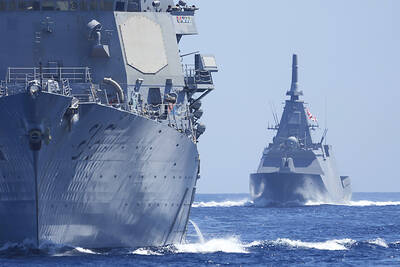India and Pakistan have agreed to hold historic peace talks to overcome enmity that kept them on war's edge for a half-century, but officials said yesterday that details were still being worked out and experience shows that the process will be menaced by pitfalls.
The peace initiative comes two years after the long-hostile neighbors went to the brink of a devastating war -- with nuclear weapons in play -- and will include all the topics, including the hot-button issue of the divided Himalayan territory of Kashmir.
"I think the victory is for the world," Pakistan's President General Pervez Musharraf declared on Tuesday following his breakthrough with Indian Prime Minister Atal Bihari Vajpayee in tightly guarded meetings in the Pakistani capital under the cover of a major regional summit.
In a joint declaration read separately by the Indian and Pakistani foreign ministers, Musharraf pledged not to permit his country to be used as a haven for terrorism, and Vajpayee promised to seek a solution to the Kashmir dispute.
Gone were the usual Pakistani denials that it had supported Islamic militants fighting Indian rule in the disputed Himalayan territory, and gone were Indian demands that cross-border infiltration stop before a dialogue could begin.
But the agreement to launch the peace dialogue in February was already facing opposition from hardliners over such details, with Kashmiri militants who have long counted on Pakistani support branding it a sellout.
Syed Salahuddin, the chief of Hezb-ul Mujahedeen, the main militant group in Indian Kashmir, warned that military operations would continue until India frees jailed militants and proves its sincerity.
"There is always room for slippages," observed Najmuddin Shaikh, a former Pakistani foreign secretary. "Past history is testimony that things can go wrong easily."
Shaikh said that the new agreement had positive elements that permitted a higher level of optimism, such as consolidating confidence-building measures that the two sides undertook since April -- such as observing a cease-fire between their armies in Kashmir -- that enabled Musharraf and Vajpayee to meet and launch the new plan.
"No time limit is also important," Shaikh said. "This will be a process that will take time, that will be sustained and continued and enlarged upon."
Foreign Ministry spokesman Masoood Khan said that the level of diplomats who will carry out the initial round of the talks, and their venue, were still being worked out.
More than 65,000 people have died since 1989 in the conflict over Muslim-majority Kashmir, divided between India and Pakistan and claimed entirely by both. Islamic rebels are fighting for independence for the part of Kashmir controlled by predominantly Hindu India, or for its merger with mostly Muslim Pakistan.
Other attempts to end the India-Pakistan feud have ended in bitter disappointment and feelings of betrayal, most recently in talks in July 2001 between Vajpayee and Musharraf in the Indian city of Agra. An attack by Islamic militants on India's Parliament in December 2001 scuttled any hopes and brought the two nations to the brink of a fourth full-scale war.

A fire caused by a burst gas pipe yesterday spread to several homes and sent a fireball soaring into the sky outside Malaysia’s largest city, injuring more than 100 people. The towering inferno near a gas station in Putra Heights outside Kuala Lumpur was visible for kilometers and lasted for several hours. It happened during a public holiday as Muslims, who are the majority in Malaysia, celebrate the second day of Eid al-Fitr. National oil company Petronas said the fire started at one of its gas pipelines at 8:10am and the affected pipeline was later isolated. Disaster management officials said shutting the

US Vice President J.D. Vance on Friday accused Denmark of not having done enough to protect Greenland, when he visited the strategically placed and resource-rich Danish territory coveted by US President Donald Trump. Vance made his comment during a trip to the Pituffik Space Base in northwestern Greenland, a visit viewed by Copenhagen and Nuuk as a provocation. “Our message to Denmark is very simple: You have not done a good job by the people of Greenland,” Vance told a news conference. “You have under-invested in the people of Greenland, and you have under-invested in the security architecture of this

UNREST: The authorities in Turkey arrested 13 Turkish journalists in five days, deported a BBC correspondent and on Thursday arrested a reporter from Sweden Waving flags and chanting slogans, many hundreds of thousands of anti-government demonstrators on Saturday rallied in Istanbul, Turkey, in defence of democracy after the arrest of Istanbul Mayor Ekrem Imamoglu which sparked Turkey’s worst street unrest in more than a decade. Under a cloudless blue sky, vast crowds gathered in Maltepe on the Asian side of Turkey’s biggest city on the eve of the Eid al-Fitr celebration which started yesterday, marking the end of Ramadan. Ozgur Ozel, chairman of the main opposition Republican People’s Party (CHP), which organized the rally, said there were 2.2 million people in the crowd, but

JOINT EFFORTS: The three countries have been strengthening an alliance and pressing efforts to bolster deterrence against Beijing’s assertiveness in the South China Sea The US, Japan and the Philippines on Friday staged joint naval drills to boost crisis readiness off a disputed South China Sea shoal as a Chinese military ship kept watch from a distance. The Chinese frigate attempted to get closer to the waters, where the warships and aircraft from the three allied countries were undertaking maneuvers off the Scarborough Shoal — also known as Huangyan Island (黃岩島) and claimed by Taiwan and China — in an unsettling moment but it was warned by a Philippine frigate by radio and kept away. “There was a time when they attempted to maneuver